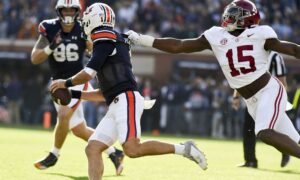Trade Up… So What?
All fantasy football players love trades! We love making trades in our leagues, and we are equally enthralled when NFL teams strike an agreement with one another. The NFL Draft weekend has annually been a prime time for teams to maneuver, most often using draft picks as the chief form of capital, moving up or down the draft depending on their current long-term plan or short-term need.
Over the past few weeks, we’ve heard a lot about some of the trades pulled off during the most recent NFL Draft. The Bears, Chiefs and Texans all made big moves to go get players they hope will be the future cornerstone of their respective organizations – quarterbacks Mitchell Trubisky, Patrick Mahomes and Deshaun Watson.
Although a pair of trades for mid-round running backs didn’t receive quite the same level of attention from the national media, many fantasy football players took note that the Saints moved up to snag Alvin Kamara, while the 49ers went off their board, selecting Utah’s Joe Williams. Along with the analytics, measurements, film work and NFL Combine performances, some have used the fact that their teams felt compelled to trade up to acquire these players as another positive sign in their future performance. On the surface, it makes a lot of sense. The Saints were so impressed with Kamara that they were willing to give up both current and future year assets to ensure he landed in their backfield, so this should give us as dynasty players an increased level of confidence, right?
To add some perspective to the recent draft, I looked back at the past five NFL Drafts and charted every offensive skill position player that teams moved up in the draft in order to select. Before we find how they’ve fared and if there is cause for these heightened expectations, let’s take a look at the full list of players from the current draft class.
[am4show have=’g1;’ guest_error=’sub_message’ user_error=’sub_message’ ]
Mitchell Trubisky, QB CHI
Patrick Mahomes, QB KC
Deshaun Watson, QB HOU
David Njoku, TE CLE
Zay Jones, WR BUF
Dalvin Cook, RB MIN
Alvin Kamara, RB NO
Taywan Taylor, WR TEN
Kareem Hunt, RB KC
CJ Beathard, QB SF
Joe Williams, RB SF
Donnel Pumphrey, RB PHI
Jehu Chesson, WR KC
Isaiah McKenzie, WR DEN
Brandon Wilson, RB CIN
A Look Back
As I perused the list of players teams had traded up to select, I began to also research how many top fantasy seasons those players have produced over the years. I found how many top 12 QB/TE seasons along with the number of top 24 RB/WR seasons the group had posted in their NFL careers. Here’s the full breakdown.
| Year Drafted | Player | Team | Number of “Starter” Seasons |
|---|---|---|---|
| 2012 | Robert Griffin III | Redskins | 1 |
| Trent Richardson | Browns | 1 | |
| Justin Blackmon | Jaguars | 0 | |
| Doug Martin | Buccaneers | 2 | |
| Stephen Hill | Jets | 0 | |
| Alshon Jeffery | Bears | 2 | |
| Ronnie Hillman | Broncos | 1 | |
| TJ Graham | Bills | 0 | |
| Bernard Pierce | Ravens | 0 | |
| TY Hilton | Colts | 4 | |
| Lamar Miller | Dolphins | 3 | |
| Taylor Thompson | Titans | 0 | |
| 2013 | Tavon Austin | Rams | 0 |
| Cordarrelle Patterson | Vikings | 0 | |
| Justin Hunter | Titans | 0 | |
| Vance McDonald | 49ers | 0 | |
| Matt Barkley | Eagles | 0 | |
| Ryan Nassib | Giants | 0 | |
| Johnathan Franklin | Packers | 0 | |
| Zac Stacy | Rams | 1 | |
| Mike James | Buccaneers | 0 | |
| 2014 | Sammy Watkins | Bills | 1 |
| Brandin Cooks | Saints | 2 | |
| Johnny Manziel | Browns | 0 | |
| Teddy Bridgewater | Vikings | 0 | |
| Jordan Matthews | Eagles | 2 | |
| Cody Latimer | Broncos | 0 | |
| Carlos Hyde | 49ers | 1 | |
| Allen Robinson | Jaguars | 2 | |
| Terrance West | Browns | 1 | |
| Devin Street | Cowboys | 0 | |
| Zach Mettenberger | Titans | 0 | |
| Mike Campanaro | Ravens | 0 | |
| 2015 | Melvin Gordon | Chargers | 1 |
| Devin Funchess | Panthers | 0 | |
| Maxx Williams | Ravens | 0 | |
| Tyler Lockett | Seahawks | 0 | |
| Jaelen Strong | Texans | 0 | |
| Chris Conley | Chiefs | 0 | |
| Bryce Petty | Jets | 0 | |
| Brett Hundley | Packers | 0 | |
| Geoff Swaim | Cowboys | 0 | |
| 2016 | Jared Goff | Rams | 0 |
| Carson Wentz | Eagles | 0 | |
| Will Fuller | Texans | 0 | |
| Paxton Lynch | Broncos | 0 | |
| Leonte Carroo | Dolphins | 0 | |
| Connor Cook | Raiders | 0 | |
| Jakeem Grant | Dolphins | 0 | |
| David Morgan | Vikings | 0 | |
| Brandon Doughty | Dolphins | 0 |
These 51 players have posted a total of 24 “starter” seasons across 159 potential seasons, a 15% clip. Obviously, players from the 2016 NFL Draft have had just one opportunity to accomplish a starter season, while the 2015 draft class has had two chances and so on.
Draft Capital Matters
Through this look back, I noticed many teams tended to trade up for players late in the draft and it only makes sense that the late rounders would be less likely to produce a top season compared to their highly-drafted counterparts. That led me to break down the data in another way.
I sorted the 51 players by day selected with Day One representing first round players, Day Two for second and third rounders and all other players falling to Day Three. Here’s what that looks like.
| Draft Day | Number of Players | Number of Opportunities | Number of “Starter” Seasons | Percentage of “Starter” Seasons |
|---|---|---|---|---|
| One | 15 | 46 | 8 | 17% |
| Two | 19 | 64 | 12 | 19% |
| Three | 17 | 49 | 4 | 8% |
It should not be a surprise to see players drafted on the final day have a relatively low chance to producing a starter-level season, but all players in the top three rounds essentially have produced top fantasy seasons at the same rate.
An Overall Perspective
Through doing this research, I was unsure if the 15% overall clip, along with the above breakdowns by round and day drafted should actually give up hope for the Kamaras and Williams of the recent draft class. In short, are these rates good?
To answer this question, I found the same data for all fantasy relevant players that were drafted either in the team’s original spot or via a “trade down.” The sample size was very different, but offers a perspective on the previous data. As a reminder, this encompasses all quarterbacks, running backs, wide receivers and tight ends drafted from 2012-2016.
| Draft Day | Number of Players | Number of Opportunities | Number of “Starter” Seasons | Percentage of “Starter” Seasons |
|---|---|---|---|---|
| One | 28 | 84 | 24 | 28% |
| Two | 81 | 247 | 34 | 14% |
| Three | 240 | 702 | 15 | 2% |
With the larger sample size, we see the cream rise to the top, as players drafted in the first round have produced a starter level season 28% of the time, compared to the respectable 17% of those players who were trade up targets. On the other hand, the Day Two players see a drop in comparison to the earlier group of players discussed, though still in a reasonable range. Day Three prospects who were trade targets already faced an uphill battle with only an 8% hit rate, but with only 2% of players producing a start season, there is a significant gap between the trade targets and players drafted in the traditional manner.
Class of 2017
Now, back to the class of 2017. All of this information, namely the 8% hit rate over the past five years, does not look good for the players drafted from the fourth round on, including one of the hot names in the dynasty community in recent weeks, 49ers running back Joe Williams. The data does suggest though that we can prioritize these players ahead of those who were not selected via a trade up.
With a nearly 20% hit rate and ten players traded up for and drafted in the top three rounds in 2017, recent history suggests we can only count on two of these players to be fantasy producers for fantasy teams.
Conclusion
While late round trade targets have been far more productive than their counterparts, those players drafted via a trade up in the first-round have actually not met the pace of others selected in the top 32 overall picks. Perhaps this can be blamed on the quarterback position, the one that NFL teams are constantly chasing. Of the six signal callers drafted in round one through a trade up, they have combined for just one top 12 season, and none since 2012. This speaks to the desperation NFL teams feel when trying to lock down a long-term starting quarterback.
Otherwise, there is little significant difference in the outlook for players acquired via trade up in rounds one through three compared to those who are not.
[/am4show]
- Monday Mocks: Expert 2024 Rookie Mock Draft - April 22, 2024
- Monday Mocks: 2024 Landing Spots - April 15, 2024
- Five Landing Spots That Would Tank Rookie WR Value - April 13, 2024


































































